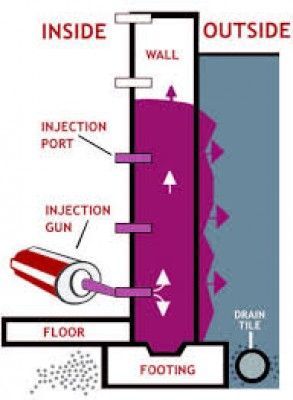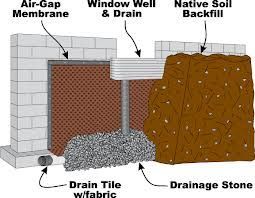Our Services
Basement Waterproofing and Repair in Ottawa
We have been repairing wet basements in Ottawa and surrounding areas since 1976. We have the expertise to get the job done quickly, effectively and permanently. There is not a job too large or too small – and there’s no wet basement in Ottawa that we can’t repair and render waterproof!
Wet basement problems are as old as the structures themselves. Water will leak into a basement through any opening it can, including your foundation walls, floors, and the joints between them. Water can even pass through the concrete itself – which is one reason why basements are notoriously damp, humid spaces.
One telltale sign is efflorescence (a white powdery deposit) around the floor/wall seam and cracks in the floor and/or walls. We are experts in diagnosing and repairing moisture problems using the most effective and up-to-date systems.
Contact us today at
613-761-8919
for a
FREE, no-obligation waterproofing Ottawa estimate!
- Exterior excavation and weeping tile installation/replacement
- Exterior application of waterproofing membranes
- Air-Gap membranes, e.g. Platon
- Exterior application of insulation and drainage products (clear stone)
- Window well drainage repair and installation
- Interior water control systems (drains, sump pump and pit and evacuation hardware)
- Interior epoxy or polyurethane crack injection
Foundation Crack Injection and Repair in Ottawa
Your foundation is one of the most important aspects of your home because it supports your entire house. Even if you don’t think of your foundation as your first floor, your house does.
Both the structure and the air quality of your basement have an effect on that part of your home that you live and sleep in. Wood rot, cracks, mould, moisture, water and pests can all cause harmful damage to your living spaces and the people who occupy them. Most can be attributed to foundation crack problems.
Ardel Concrete Services – Your Ottawa Foundation Crack Repair specialists!
If you are looking for foundation contractors with a specialty in crack injections then you have come to the right place as we are Ottawa’s top choice for service and customer satisfaction.
Contact us today at 613-761-8919
for a FREE, no-obligation foundation crack injection and repair estimate!
- Block, poured concrete, stone foundation repairs
- Structural crack repairs (settlement)
- Non-structural cracks, form pins, holes etc. (polyurethane injection and/or excavation/waterproofing)
- Horizontal cracks (bowed walls, rusted rebar)
- Foundation stabilization (rebar, epoxy, carbon/Kevlar straps and staples, underpinning)
Window Well Repair and Installation in Ottawa
We have been offering window well repair and installation services in the Ottawa region for over 40 years. Our service area stretches from Rockland to Carleton Place.
Window wells provide positive drainage away from the foundation by allowing the ground to be raised. The vertical drain within the well is to protect water from rising to the window level and causing your basement to leak. This vertical drain sits on top of the stone covering the weeping tile, allowing the water to enter the weeping tile system.
Window well failures are common occurrences. They are a result of either improper installation and/or lack of maintenance. Depending on the age of the house, the weeping tile may be blocked or worse, not there. There are, fortunately, other methods to attain a good positive slope away from the house without using the weeping tile system.
Window wells require maintenance. Window wells are like eavestroughs, often overlooked until backups occur and the cleanup begins. They are collectors of debris such as leaves, paper etc. We recommend that in the late fall a visual inspection and cleaning be done. Verify that your window wells remain well attached to the foundation. A reputable contractor would fix any potential problems. It is just good PR.
We can offer you free consultation
on other options where window wells will not meet your needs.
The Right Way
to Install and Repair Window Wells
- Excavate to the weeping tile, clean, and water test
- Cover the weeping tile with a foot of 3/4 inch clear stone.
- Install a 4 inch perforated drain with filter fabric nestled in the stone to below the window sill.
- Wrap a filter fabric around the base of the pipe and cover the stone.
- The well should be deep enough to project a minimum of 6 inches below the window sill.
- The well should be high enough to provide positive drainage away from the foundation.
- It must be bolted to the foundation (prevent frost lift)
- It must be caulked on both sides and clear stone should be placed in the well.
Concrete Garage Floors, Walkways, and Patios
Ardel Concrete Services Ottawa has been offering garage floor replacement due to cracking settlement and/or heaving since 1976. Also, in conjunction with around the house excavation/waterproofing, we can replace existing affected concrete structures (walkways) with regular concrete or stamped.
Ardel Concrete Services – Your Ottawa Concrete Garage Floors Specialists!
Contact us today at
613-761-8919
to discuss your stamped concrete project in Ottawa and surrounding areas.
- One of the most durable aggregate materials available
- Longevity
- Cost-effective in comparison to other materials
- Virtually endless design possibilities
- Versatile in blending with other architecture and landscaping
- Customizable
- Short installation process
- Low maintenance (no weeds or insects)
Garage Foundation/Floor Repair
Discovering issues with your foundation can be stressful and frustrating. There are many reasons why you may be in need of a foundation repair in Ottawa. However, water is often the main culprit.
At Ardel Concrete, we can help repair all types of foundation issues and solve any structural or water problems. Learn more about our foundation repair services below.
Your Foundation Repair Expert in Ottawa
At Ardel Concrete, we take foundation repair concerns seriously. Our foundation contractors will diagnose each problem carefully and decide whether a structural or non-structural solution is needed. There are different approaches required for each issue, and we don’t recommend trying to diagnose or fix the issue yourself.
At Ardel Concrete, we put you and your safety first. For your peace of mind, we have emergency services that are available 24/7.
Contact us today at 613-761-8919
for a free quote about your foundation repair needs!
Signs You May Need a Foundation Repair
Depending on your situation, foundation concerns may be spotted on the interior or the exterior of your property. Outside, you may identify cracked bricks, garage door separation, rotating walls, or cracked or displaced mouldings. Inside your home, you may notice uneven floors, cracks in the floors or walls, unbalanced doors and windows, and more.
It’s crucial that these issues be addressed as soon as they are noticed. The foundation supports the integrity of your entire home, so when something is off, there are some serious risks involved. Our team of experts at Ardel Concrete can help diagnose and fix the problem with ease.
What Causes Foundation Issues?
Foundation repairs are often needed due to exposure to water and moisture. When moisture seeps into the soil where your foundation lies, this causes the foundation to move.
Soil that is high in clay content is the easiest to manipulate when wet. Other reasons why your foundation may move or be susceptible to damage is if it was built on land that deals with major weather changes, floods and earthquakes, poor drainage, or if the home was built on an incorrect foundation.
Another contributing factor is when the gutters or eavestroughs are clogged, and excess water spills onto the yard. This causes the yard to flood, soaking the soil. Slanted landscaping can help if drainage is a problem. However, this isn’t always possible when living in a developed neighbourhood.






